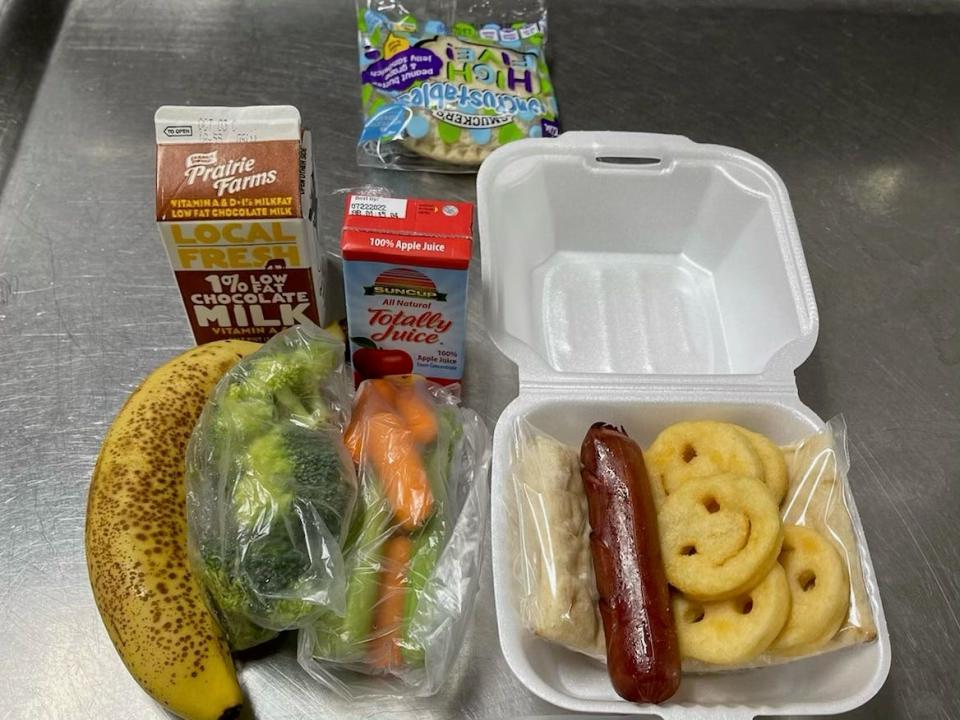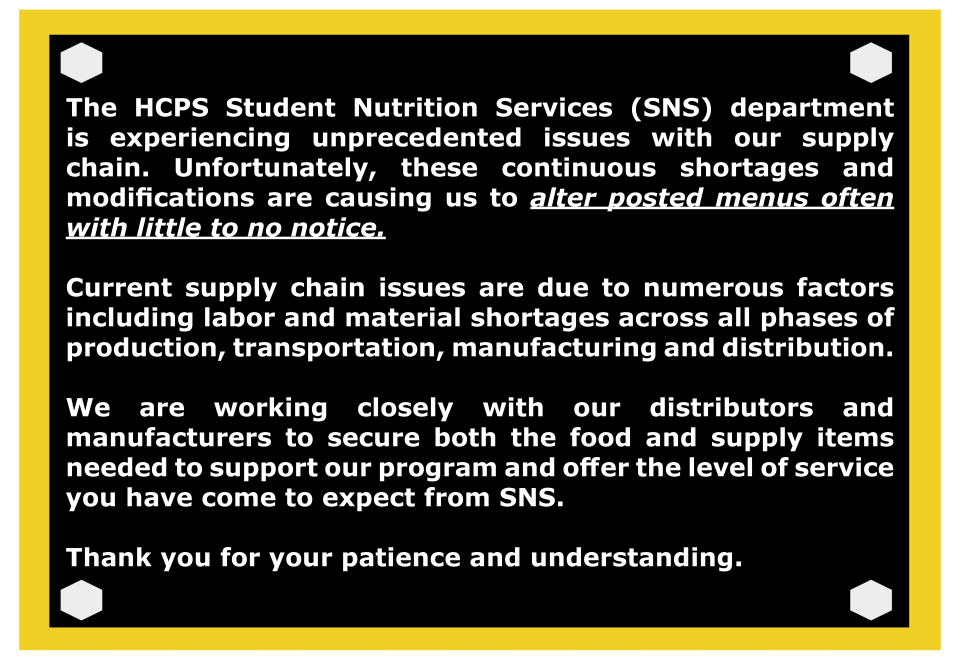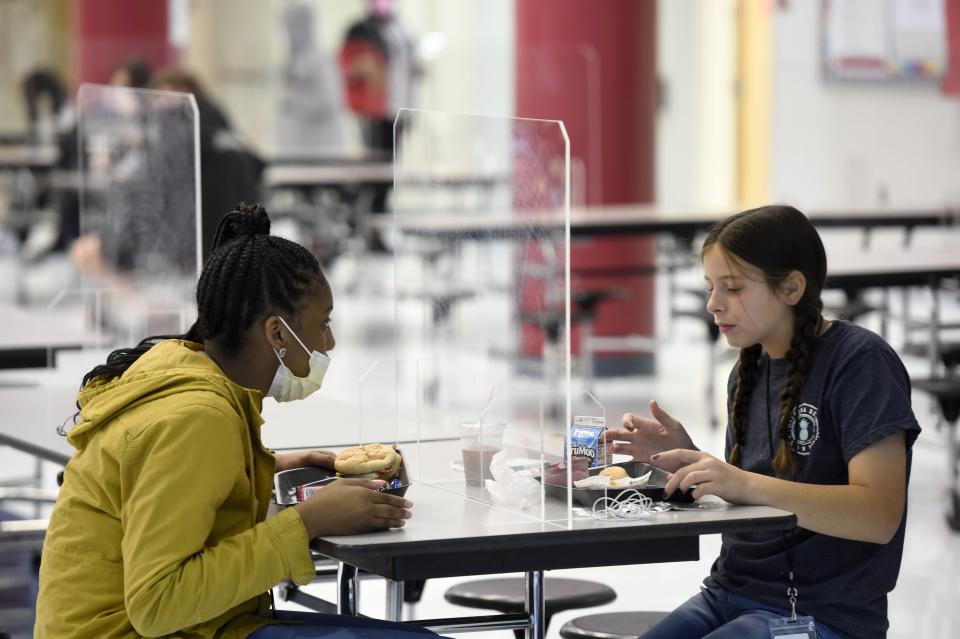Hot dog tortillas and bagged salads: School lunches take on new look amid supply-chain woes
When a peanut butter and jelly sandwich is replaced with dried fruit and animal crackers, it's evident supply-chain issues have all sort of lunch menus out of whack.
Across the country, school cafeteria managers are scrambling to put together a nutritious meal, losing out on some favorites and trying to make any available ingredients work.
The supply-chain crunch has made certain foods unavailable and supplies hard to obtain, affecting another sector that is hoping to bounce back soon.
School food-program directors nationwide have been forced to serve salads in bags and swap out hot dog buns for tortillas, after delayed deliveries, canceled orders, shortages and cost surges, Diane Pratt-Heavner, with the School Nutrition Association, told USA TODAY.
Peanut butter jelly time: How healthy is the American classic? Experts weigh in
We've got it? I'll take it.
For Hillsborough County Public Schools in Tampa, the issue started with chicken. Nuggets, tenders or sandwiches weren't making the serving line at the beginning of the school year. As time passed, other items made rare appearances on menus including grain products.
Shani Hall, the general manager of school nutrition for Hillsborough County Public Schools, said pizza, pasta, bread and cereal are scarce. Another student favorite, peanut butter and jelly sandwiches, soon got added to the list of unavailable lunches.

"We had to get creative so we’re using crackers,” Hall said. "We've had to come up with all other types of munchables for example, banana loaf and dried fruit. We’re trying to come up with anything that will do to replace that peanut butter and jelly meal and that has been really difficult.”
In Clarksville, Tennessee, students have received hamburgers and hot dogs with no buns. Instead, they were served tortillas, flatbreads and wraps, even crackers.
"There's nothing unique about what were experiencing outside of what everyone is experiencing. It’s the same across the nation," Director of child nutrition Shane Tarkington told the Leaf Chronicle, a part of the USA TODAY Network.
An American classic: White or wheat? Best peanut butter-to-jelly ratio? This is how you make the perfect PB&J sandwich, according to experts
Hillsborough County Public Schools had to add a disclaimer to their menus to warn students substitutions will happen.
"Everybody thinks that that food is coming in but then it doesn’t come in and we have to find something to put in its place,” Hall told USA TODAY.
Paper or plastic?
It's not just food: Schools are also not receiving items such as paper trays that are stuck in the supply chain. With utensils and trays in short supply, students in Tampa have been given salads in plastic bags, Tarkington explained.
“It’s really getting challenging. I’m getting concerned on the supply issue because it doesn’t look like it’s improving." Hall continued, "It’s not feeling like we’re getting out of this anytime soon.”
Biden's plan: School lunches, IRS agents and HBCUs: The under-the-radar proposals in Biden's budget plan

One week, soup made a return to the menu in Hillsborough County but suddenly staff realized there were no trays or bowls to put it in. Directors are forced to think quick to solve the numerous issues thrown at them on a weekly basis.
Some food program directors have taken the matter into their own hands by going directly to the source to get what students need.
"When their orders aren’t delivered – they are having to place additional orders at a higher cost, find new local suppliers, in some cases, even work with local restaurants or purchase items at Costco or local restaurant depos," Pratt-Heaver told USA TODAY.
Pizza boxes, Ziploc bags and takeout trays are some ideas that directors consider to serve their students, no matter how unconventional it is.
"School nutrition staff are passionate about making sure students are nourished and ready to learn - they will make sure children don't go hungry," Pratt-Heavner said.
Severe inflation: Food prices are climbing amid worker shortages, supply-chain problems, extreme weather and more
Federal aid
In June, the School Nutrition Association relayed the supply-chain issues to the United States Department of Agriculture.
The USDA issued waivers that prevent school meal programs from being financially penalized if shortages prevent them from meeting certain federal requirements.
"They have also provided emergency procurement waivers, so schools don't have to go through a time-consuming competitive bid process for purchases," Pratt-Heavner said.

Students are able to receive meals free of charge through June 2022 as the pandemic continues to endanger our food and nutrition the USDA said in a press release.
Although the Hillsborough County Public Schools are able to stay afloat, the federal aid increased student participation which helps fill the gaps because prices are so much higher.
"Having the kids eat free is more incentive because it’s less parents have to worry about and it helps the program so much more,” Hall told USA TODAY.
The USDA also announced forthcoming funds to help address rising costs for the programs.
Contributing: Alexis Clark
This article originally appeared on USA TODAY: School lunches in supply-chain crunch force cafeterias to get creative

